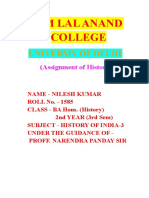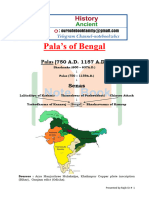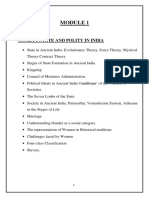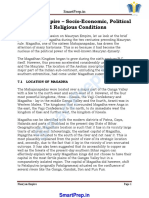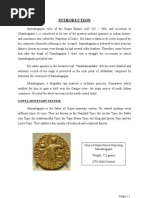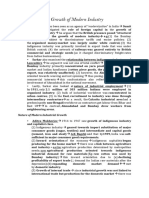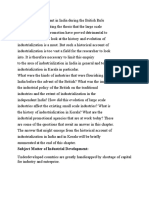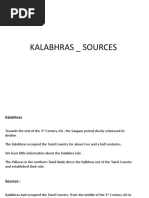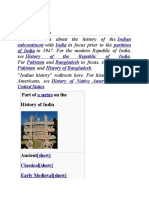8.1 Early Medieval India, Indian Feudalism and Alternative Histories
8.1 Early Medieval India, Indian Feudalism and Alternative Histories
Uploaded by
Shreya SinghCopyright:
Available Formats
8.1 Early Medieval India, Indian Feudalism and Alternative Histories
8.1 Early Medieval India, Indian Feudalism and Alternative Histories
Uploaded by
Shreya SinghOriginal Title
Copyright
Available Formats
Share this document
Did you find this document useful?
Is this content inappropriate?
Copyright:
Available Formats
8.1 Early Medieval India, Indian Feudalism and Alternative Histories
8.1 Early Medieval India, Indian Feudalism and Alternative Histories
Uploaded by
Shreya SinghCopyright:
Available Formats
Early Medieval India, Indian Feudalism and Alternative
Histories
Subject: History
Unit: Towards Early Medieval India
Lesson: 8.1: Early Medieval India, Indian Feudalism and
Alternative Histories
Lesson Developer Prof. Bhairabi Prasad Sahu
College/Department: Professor, Department of History,
University of Delhi
Institute of Lifelong Learning, University of Delhi
Early Medieval India, Indian Feudalism and Alternative
Histories
Table of contents
Chapter 8: Towards early medieval India
• 8.1: Early medieval India, Indian feudalism and alternative histories
• Summary
• Exercises
• Glossary
• Further readings
Institute of Lifelong Learning, University of Delhi
Early Medieval India, Indian Feudalism and Alternative
Histories
8.1: Early medieval India, Indian feudalism and alternative
histories
Introduction
The post Gupta period ranging from about the sixth to the thirteenth century has been seen
to constitute the early medieval period in Indian history. It is seen as a stage anticipating
the transition to the medieval times. Serious efforts at defining the early medieval period
can be dated to the later part of the 1950s onwards. The works of D. D. Kosambi and R. S.
Sharma together with those of Lallanji Gopal and B. N. S. Yadava inaugurated a trend which
focused on the interrelationship between economy, society and polity. This helped the
explanation of historical developments, including transitions in early India, and raised
discussions to the level of conceptualizations. Thus was born the school of Indian feudalism,
which distinguished the early historical from the early medieval and equated the latter with
feudalism. In the course of discussing and accounting for change this historiography
enriched the understanding of society and economy of the times within wider
generalizations, thanks to the contributions of many eminent historians. This historiography
identified large, durable, common institutional structures with trans regional reach, spread
over centuries. By the later 1970s and early 1980s the intellectual unease with the feudal
framework resulted in alternative models or explanations of state and society. While Burton
Stein argued for a peasant state and society, leading to a segmentary state, Hermann Kulke
and B. D. Chattopadhyaya put forward their integrative model. At this juncture two brief but
obvious clarifications may be necessary. First, the opposition to Indian feudalism did not
wait to emerge till the late1970s, almost immediately after the publication of Sharma’s
Indian Feudalism the idea was questioned by D. C. Sircar in 1966. The believers and
opponents of the formulation grew in course of time. The long debate had both factual and
ideological foundations. However the long drawn debate on terms set by its proponents
almost up to the end of the 1970s led to the making of a stereotype. The later alternative
frameworks avoided it by shifting the ground of discussion and focusing on the processes at
play. We shall return to it soon. Secondly, it may be necessary to clarify what is meant by
alternative histories. Alternative histories also concentrate on similar issues and concerns,
but they do it differently by addressing the sources with new sets of questions and
perspectives.
Institute of Lifelong Learning, University of Delhi
Early Medieval India, Indian Feudalism and Alternative
Histories
There are three different contending explanatory models for understanding the early
medieval Indian situation. The Indian feudal model of self-sufficient, relatively closed rural
economy characterized by an essentially bipolar world of lords and peasants and
proliferation of castes as also decentralized feudal states; the model of ‘ peasant state and
society’ visualizing a Brahmana-peasant alliance and segmentary state focusing on the
pyramidal repetition of the structures in the numerous autonomous segments (Nadus), as
were available in the core; and the model of integrative state and social formation
demonstrating the phased structural evolution of imperial kingdoms or regional/supra
regional states and societies across regions. At present the first and the third formulations
are in contention for the minds of people, while the second framework, which had generated
interesting debates in the 1980s, suffered relative eclipse owing to the dearth of passionate
adherents. Notwithstanding their relative merits, these concepts “succeeded in effectively
destroying the ‘conventional’ picture of the medieval regional kingdoms as centrally
governed unitary states for North as well as South India”. They also undid the notion of the
Dark Ages which was usually ascribed to the early medieval centuries by focusing on the
processes and potentials of change. These centuries are increasingly being seen as dynamic,
generative and foundational.
Indian feudalism
The origins of Indian feudalism is located in land grants to brahmanas and temples from the
Gupta period onwards, and later to state officials, involving the alienation of fiscal,
administrative and judicial rights. The emergence of multiple centres of power and a great
deal of decentralization, consequent to continuous, systematic parcellization of
sovereignty or state power which increasingly devolved on to the donees, making them
independent lords, has been identified with feudalism. The many, hierarchised centres of
power, different grades of samantas (such as mahamandalesvara, mandalika,
mahasamanta, samanta, laghusamanta, etc.), and graded land rights are perceived to be
the result of state activity, i.e., land grants. Decline of long-distance and maritime trade,
paucity of money, and urban shrinkage apparently nicely rounded off the argument.
However the decline of trade-towns-money thesis leading to the emergence of Indian
feudalism had its share of ideological problems from the beginning, insofar as an external
factor such as trade was perceived to account for momentous internal developments
invoking the transition to a new social formation. Not surprisingly therefore in the late
1970s and early 1980s the idea of the Kaliyuga crisis was posited as an alternative or
supplementary causative factor explaining the passage to feudalism. In this case land
grants were allegedly made to neutralise the pervasive social crisis, but it is another matter
that they went on to usher in significant socio-political changes, including relatively closed,
Institute of Lifelong Learning, University of Delhi
Early Medieval India, Indian Feudalism and Alternative
Histories
self-sufficient villages. The growth of localism, regionalism and closed mindsets are ascribed
to these developments. Notwithstanding the proliferation of castes and the emergence of
new social categories such as the Rajputs and Kayasthas, society is usually perceived in
bipolar terms, the lords and the peasants. The peasants we are told were subjected to
several exactions, including forced labour, loss of community rights to forests, pasture,
ponds and grazing grounds, and even eviction. Sharp social divisions, we are told, led to
peasant unrest. Besides, there is also a tacit assumption that the land grants across regions
were made from an epicenter with uniform consequences. While the idea of Kali Age crisis
was redeeming Indian Feudalism, almost simultaneously Harbans Mukhia raised important
questions relating to the absence of structured dependence of the early medieval Indian
peasantry and their very little subsistence requirements compared to those in feudal Europe
and queered the pitch. This was soon followed by the works of Burton Stein, Hermann
Kulke, and B. D. Chattopadhyaya. The idea of Indian feudalism in general, with bearing on
its varied dimensions, has been persuasively argued for and defended by R. S. Sharma, B.
N. S, Yadava, M. G. S. Narayanan, D. N. Jha, R. N. Nandi, and Suvira Jaiswal, among
others. Nevertheless, the economic and social dimensions seem to have largely subsumed
the political.
The origins of Indian feudalism still remain to be satisfactorily explained. The problems
concerning the idea of the decline and decay of towns, trade and money, among other
issues, have been discussed earlier by D. C. Sircar, B. N. Mukherjee, John Deyell, and K. M.
Shrimali and an assessment of the situation is available in the writings of Chattopadhyaya in
the mid 1990s. While the exponents and adherents of Indian feudalism argue for shrinkage
in the non agricultural sector of the economy during the seventh-tenth centuries, others
have tried to see the forms in which trade and urbanism survived in the early medieval
times. Similarly, by shifting the focus from coin typology and dynastic issues to volumes it
has been pointed out that metallic coins were nearly as plentiful as in the early historic
period. The dominant understanding of rural settlements and rural society as closed and
self-sufficient has been questioned in the works of N. Karashima, Jan Breeman, and
Chattopadhyaya. They point to the plurality of rural settlements and the variation in their
spatial and social composition. All settlements did not have a tank and temple for example,
and the same social groups did not live in every settlement. The wide ranging inter-village
cooperation and rural interactions as well as the complexities of rural life have been
highlighted. That brings us to the theory of Kaliyuga crisis. It has been unmistakably
demonstrated that the alleged crisis was not a historical crisis. It was at most a crisis of
confidence on the part of the brahmanas, related to the issue of patronage in a situation of
competition from the ‘heretical’ sects and/or an ingenious invention of the brahmanas to
make people confirm to Brahmanical ideological norms in an age characterized by economic
growth, social change and the spread of state societies within the Brahmanical framework
outside Gangetic north India. The thesis of decentralized, fragmented feudal polity rests on
the presupposition of an evenly spread Mauryan empire of uniform administrative depth
across the country, which did not change much under the Kushanas and Satavahanas
5
Institute of Lifelong Learning, University of Delhi
Early Medieval India, Indian Feudalism and Alternative
Histories
leading up to proto feudal Gupta times. However, recent writings on the nature of the
Mauryan state questioning the assumed degree of centralization and standardization or
homogenization of the empire, and a different perspective of post Mauryan states focusing
on uneven developments and plurality of cultures disturb this understanding. The
continuous moving of the peasant frontier and enormous socio-cultural changes are
reflected in the systematization of the idea of varnasamkara and the invention of new
ones such as apaddharma, Kali yuga, as well as the emphasis on duty or dharma.
Similarly, the brahmanas and religious institutions, who were recipients of royal land
donations from the Gupta period onwards, instead of being perceived as agents of
decentralization have been revisited and seen as pace makers of royal authority. The
related issues are the object of donation, which were usually a grama (village), palli
(hamlet), pataka (part of a village), measures of land, etc, the quantum of such donations
and their relationship vis-a- vis the land under cultivation across regions. For example, one
is not sure how seriously a brahmana donee with some land or a part of the village would
effect agrarian relations in the settlement. The rich peasants in the settlement could have
had similar quantities or more land. Similarly, one needs to rethink the consequences of a
few brahmanic settlements in a larger agrarian locality. These are important for the
characterization of the donees and the emergent social formation. One may add that the
early assignments were to the brahmanas and religious establishments, while the service
assignments followed and did not precede the beginnings of ‘feudal’ polity. The question
then is can the religious donees with a grama, a part of it or more be perceived as
feudatories? In case grants to them symbolized the economic and political undoing of the
state it is not intelligible as to why king after king and dynasty after dynasty continued with
the phenomenon. That apart, the regional distribution of early land grants clearly suggests
their local origins, mostly being made by one local dynasty or another in a general context
of local state formation. The case of the Matharas of Kalinga, Vakatakas of Vidarbha,
Kadambas of Kuntala, and the early Pallavas, for example, easily makes the
point. The spatial and temporal correspondence between land grants and the spread of state
societies points to their mutually beneficial, and not antagonistic, relationship.
Questions related to the hierarchy of feudatories and the making of the pyramidal political
structure, resource transfer from the subordinate to the superordinate and the genesis of
feudal polity have not been satisfactorily answered in the case of north India or south India.
Likewise, the people have been taken for granted and the need to open bridges or establish
a chord with them has not been considered to be sufficiently important within this
historiography. There has been some engagement with Bhakti as ideology of the feudal
order. However it needs recognition that legitimation of power or the constitution of
authority involves continuous negotiations with popular aspirations and engagement with
the cultural domain. Peoples and cultures are dynamic, not static. The variations in time and
space across cultures need to be recognized and appreciated. The problem largely seems to
be, as has been pointed out, the consequence of first creating the structure and then
6
Institute of Lifelong Learning, University of Delhi
Early Medieval India, Indian Feudalism and Alternative
Histories
looking for processes to explain it rather than the other way round, and this it appears is
being gradually recognized at least in the case of south India. Briefly stated, “if there is
need to look at change in early Indian history, it is necessary that historians too
occasionally introduce some change in the way they see the past”.
Value addition: what the sources say
Ratnagir plates of Somavamshi Karna
“In the province of Uttara-Toshali (there is a village called) Kona-gram (consisting of
eighteen parts); having honoured the brahmanas of that khanda (district), we
declare this charity (and order) before the offices (such as) the samaharti, the
niyukta, the adhikarika, the dandapasika, the pisuna, the vetrika, the avarodhajana,
the rajni, the ranaka, the rajaputra, the rajavallabhas, the bhogjanas etc. and before
all the inhabitants (of the district).
That this village, together with the lands, the water, the tanks, the marsh, the
various kinds of trees including the mango and madhuka in the boundaries, (also)
with the upanidhis, the hasti-danda (elephant stick?), the oxes, the chittola (?), the
andharua (?), the pratiandharua (?), the adatta (?), the padatijvya (right to maintain
foot-soldiers ?), the antarabaddi, the rintakabaddi (?), the Vasavaki (?), the vishayali
(?), the ahidanda (serpent-stick ?), the hala-danda (plough-stick ?), the vandha-
danda (?), the vandapana (receiving of sacred honour), vijaya-vandapana (receiving
of sacred and victorious honour, etc including many margganis), (and also with the
rights of) collecting assessment in future, (expressing power on) the Khandapalas,
with prohibition of all sorts of oppression.
Source: Ratnagir plates of Somavamshi Karna in Rajguru, S. 1966.
Bhubneshwar: Orissa State Museum, 10, vol. IV.
Peasant state and society
Burton Stein’s segmentary state model in south Indian history is an important conceptual
contribution to our understanding of early medieval Indian polity. The basic argument was
published in the form of a substantial article in 1977 and the formulation continued to be a
part of his Peasant State and Society in Medieval South India. The Chola state, it is said,
was characterized by limited territorial authority as one moved from the core to the
periphery, through the intermediate zone. In fact, in the periphery it shaded off into ritual
Institute of Lifelong Learning, University of Delhi
Early Medieval India, Indian Feudalism and Alternative
Histories
sovereignty. In this system of replication of uniformity across the numerous peasant locality
units or nadus the Chola centre had no monopoly of legitimate state authority. To elaborate
Stein makes a distinction between political authority and ritual sovereignty, and it is the
latter that the Chola kings are supposed to have exercised. Their political competence and
precedence was linked to their patronage of Rajarajesvara or Brihadeshvara at Tanjavur,
who enjoyed a preeminent position in relation to the other deities and cults at various levels
in the region. The land grant charters with their long prasastis seem to have spread the
message of royal greatness and augmented the constitution of ritual sovereignty. This
explanation of ritual sovereignty, as distinct from political authority, as the major sustaining
factor of the state, spread over four hundred years, has come in for major criticism. So has
the perception of the nadus as continuously unchanging, autonomous, harmonious peasant
units, characterized by brahmana-peasant alliance. Clearly, there are difficulties in
accepting the suggestion that the peasants collaborated in their own exploitation or that
they could not see beyond their immediate self interest because of which the peasant
localities or nadus did not change for centuries. The abstraction of the political and
economic dimensions of the state and the underplaying of significant issues such as
resource mobilization and the sustenance of the political order, especially in a period of
enormous agrarian expansion and commercial growth, have attracted the attention of a
number of historians. For certain periods of the history of the Chola state empirical evidence
provides a different picture. In fact, four phases have been delineated in the trajectory of
the evolution of the Chola state. G. W. Spencer’s idea of the politics of plunder is certainly
not a sufficient long-term explanation accounting for the stability of the political structure,
and in this case lasting for about four centuries. Wars can be a short-term tactics, not long-
term strategy. It needs to be mentioned that subsequently Stein understood the problems
inherent in dichotomizing ritual and political sovereignty. He admitted that in the Indian
situation the statement had to be modified because kingship combined both ritual and
political authority. Again, he conceded ground on the question of the supposedly unchanging
nadus.
Criticisms apart, and there has been no dearth of it, it needs to be recognized that the
model of segmentary state administered the necessary shock treatment to historians of
south India in particular and stirred them to the problems and possibilities of early medieval
south Indian history. In focusing on the nadus and ritual sovereignty, Stein drew attention
to the peasant localities as the basic building blocks in the construction of the history of the
regions, as well as the importance of the sacred domain in consolidating temporal power. He
also deserves our gratitude for drawing attention to and highlighting the political function of
royal prasastis (eulogies) engraved on copper-plates or stone temples. Recent writings in
the area, bearing on the structure of polity, seem to have been directly or indirectly
influenced by his intervention.
Institute of Lifelong Learning, University of Delhi
Early Medieval India, Indian Feudalism and Alternative
Histories
The integrative framework
The integrative model of state formation in early medieval India is an integral part of the
processual approach. Unlike the feudal model it locates the political processes at play in the
regions, mostly outside the Ganga valley, and then moves on to work out the emerging
structure of polity and society. Within the regions the sub-regions and localities receive the
necessary attention. This follows from the recognition of the fact that regions are not given
but historically constituted entities. In other words instead of simply asserting a paradigm
from the top the framework takes cognizance of the developments from below. Integration
operated not only at the territorial and political levels, but also in the economic, social and
cultural spheres. State formation involves the emergence of state polities in pre-state
territories and their structural evolution in the larger context of simultaneous socio-
economic and cultural transformations. The beginnings of the approach may be situated in
the early works of Chattopadhyaya and Kulke in the early and mid-1970s, in Rajasthan and
Orissa respectively. The first conceptual papers synthesizing the implications of their
findings in the wider context of comparable perspectives from other regions was published
in the early 1980s. Through that decade it became obvious that there was a remarkable
correspondence between these findings and the conclusions drawn from independent
researches on the middle of the first millennium B.C., Mauryan and Post Mauryan times. A
long-term interconnected vision of Indian history looking at change through continuity
began to emerge. Stated briefly, the idea of structurally different mahajanapadas converged
well with the recent perspectives of the uneven presence of the Mauryan state across
regions. Similarly, the differential levels of interaction of the core of the Mauryan state with
the far flung areas of the empire largely owing to disimilar patterns of historical growth tied
up quite well with the process of secondary state formation in Kalinga, Andhra and the
Deccan in the subsequent centuries. Change in these areas, even if uneven, was a result of
their interaction with the Mauryan state and internal evolution of local societies rather than
administrative integration. Developments such as these did not end with the coming of the
Gupta period, they continued through out Indian history.
From the Gupta period onwards there was an immense acceleration in the spread of state
societies largely owing to the process of local state formation. The Maitrakas of Valabhi,
Vakatakas in the Deccan and Vidarbha, Kadambas of Banavasi, Pallavas of Kanchi,
Ikshvakus and Vishnukundins of Andhra, the Matharas and Early Eastern Gangas of Kalinga
and the Sarabhapuriyas of Daksina Kosala are good examples of early local dynasties in
varied regional contexts. Examples such as these can be multiplied. However the more
general point is that these states emerged not from the fragmentation or break-up of any
erstwhile large kingdom but from changes taking place within local societies. The gradual
Institute of Lifelong Learning, University of Delhi
Early Medieval India, Indian Feudalism and Alternative
Histories
political and territorial integration together with the structural evolution of the states in
early medieval India is built on this foundation. The envisaged stages though remain the
same are labeled differently, either as chiefdoms, early kingdoms and imperial kingdoms or
as local, sub-regional and regional/supra-regional polities by Kulke and Chattopadhyaya.
The compulsions of the rajas and other structural features of the state at different stages
(such as the coming together of nuclear areas, enlargement of the core region, shifting of
the capital to a more central place, change in the structure of legitimation, etc.) have been
convincingly addressed. The stages in the evolution of the state converged with many,
simultaneous processes of change in the economic, social and cultural domains. The
numerous peasant segments or localities were not unchanging entities; they were
continuously integrated with larger units. The legitimatory strategies, which are culture
sensitive, also changed with time and context. There was a movement from local,
autochthonous deities to Brahmanized state deities and subsequently monumental temples
with wide regional appeal. The forms of legitimation did not, and could not, remain the
same all through.
Integration was never complete or perfect; it was, as it usually is, a continuous process.
Conflicts and challenges apart, there were always autonomous spaces within the ambit of
the state, pointing to the futility of looking for the uniform, homogeneous presence of the
state. Such spaces did not remain eternally so. They existed in situations of interaction with
state societies and of course changed with time. Spaces and peoples transformed from
jungles to jungle kingdoms, and even evolved state societies. The state in this perception
was not a static entity. It was dynamic, multi layered, polycentered, and expanding or
shrinking regularly. The works of several scholars on Orissa, Bengal, Rajasthan, Andhra,
and Tamil Nadu, among others, easily tie up with this frame of analysis. The Integrative
model did not invent everything anew. What is interesting is that they brought new
perspectives to bear on some of the already existing ideas. The idea of segments was
accepted devoid of its entirely autonomous and unchanging character. It now read
segmentation and integration. They
gradually became part of larger entities. The role of the sacred domain in the constitution of
political authority was acknowledged. However the religious domain was no substitute for
actual authority. Again, brahmanas and religious establishments instead of being perceived
as agents of political disintegration came to be seen as factors facilitating the extension and
consolidation of royal power insofar as they helped the extension of the agrarian frontier,
invented origin myths for royalty, provided grand genealogical linkages to ruling families,
and disseminated the dominant ideology.
Theoretically speaking, there was a coherent explanation of the state from the early
historical to the early medieval and beyond. Neither was the state seen to be the end result
of changes in other spheres (iron-productivity-surplus-state) nor was it the harbinger of all
10
Institute of Lifelong Learning, University of Delhi
Early Medieval India, Indian Feudalism and Alternative
Histories
other transformations (land grants-political decentralization-feudalism). In this perspective
the state was influenced by and impacted the multiple processes of societal change. As
against the feudal framework which visualizes a decline in arts and crafts during the period
A.D. 600-1000 and then a revival in their fortunes around the turn of the millennium, the
integration model locates the gradual rise of artisanal and crafts production in the larger
context of the phased growth of rural economy. The emergence of markets and merchants,
from weekly hattas and rural fairs to nodal exchange centres and long distance trade, have
been seen to be related to agrarian expansion and increased crafts production; going
beyond the confines of temples and monasteries. There were as many grades of traders like
purasreshthi and rajasreshthi, among others, as trading centres. This dynamism had a
bearing on the growth and spread of occupational and caste groups, which has usually been
expressed in terms of the proliferation of castes (jatis). In everyday life the world of the
peasant, craftsman, merchant, brahmana and king continuously interacted. Simply put, this
marks the movement away from mono-causality towards causal plurality and helps the
cause of a long-term vision of Indian history. The transitions in early Indian history, from
pre state to state society, early historical to early medieval, and even the movement
towards the medieval, within this perspective are far more comfortably negotiated and
explained.
Criticisms are the spice of life. Only when empirically valid sound theoretical formulations
acquire a following and emerge as an alternative, are they discussed, even criticized. The
integrative paradigm in the 1980s itself met with some constructive criticisms. However
from the middle of the 1990s onwards when it began to emerge as a serious alternative,
especially with the publication of Chattopadhyaya’s The Making of Early Medieval India and
Kulke’s Kings and Cults and The State in India, 1000-1700, the framework has generated,
as always with anything new, conflicting responses. It has had both admirers and critics as
well. Regional studies by a host of younger historians on Orissa, Andhra, Rajasthan, Gujarat
and Tamil Nadu. in the later part of the 1980s and 90s adopted and endorsed the
integrative framework. Among the criticisms there are broadly three kinds of reservations:
first, that the economic dimensions need to be addressed, secondly that it is essentially a
narrative of regionalism, and finally that one does not get very much about the structural
features of the state apparatus. It is widely admitted that the conceptual framework under
discussion focuses on the continuous evolution of the state, instead of giving it a spatio-
temporal fixity and treating it as static. The question is how else one addresses, for
example, states such as those of the Cholas in the south and the Later Eastern Gangas in
Orissa which spanned almost four centuries each. The benefits of such studies discerning
structural evolution of the state( instead of freezing it in time) in the above two cases as
well as Kerala under the Ceras of Mahodayapuram, Andhra under the Kakatiyas and Mewar
in Rajasthan are there for all to see. The nature of differences in the organization of
chiefdoms and early kingdoms and the later and imperial kingdoms have been dwelt in
some detail since the mid-1990s, if not earlier.One needs to say what perhaps is obvious.
Regions are a legitimate category of historical studies, a way of arranging the data. The
11
Institute of Lifelong Learning, University of Delhi
Early Medieval India, Indian Feudalism and Alternative
Histories
emergent picture across several regions then could be culled together to engage in wider
generalizations. This is unmistakably different from macro-
generalizations and regionalism. Generalizations based on perspectives derived from either
Gangetic north India or the Kaveri valley in the south surely have their share of problems.
Regionalism has to do with emotions, not reason but human cupidity and imagined
identities. In the integrative perspective locality, sub-regions and regions are not concepts
just denoting scale, they mostly define historically constituted spaces. Kuntala, Vidarbha,
Dakshina Kosala, Kalinga, Varendra, Bundelkhand, and Malwa are good examples of such
historical and cultural units. Besides, it is not only regional history but also questions related
to identity formation, the making of regional and pan Indian traditions through complex
networks of interrelationships between the local, regional and trans-regional elements,
mediated by multilateral transactions involving giving and borrowing, which interest these
historians. Admittedly, state formation and socio-economic transformation are inextricably
linked, and the point has been convincingly and repeatedly made. Kulke only mentioned it
briefly earlier and developed it a bit more later, where as Chattopadhyaya’s writings in the
first half of the1990s unambiguously made the state and economy interrelationships clear.
The story of phased economic growth and structural evolution of the state can also be seen
in several writings in the context of Tamil Nadu, Andhra, Karnataka, Orissa, Assam and
Rajasthan, for example. The growth of agrarian economy leading to marketable surplus and
the emergence of markets and merchants as well as the state’s growing interest in mandis,
hattas, penthas, and nagarams ( in north India, the Deccan and the south respectively) has
also been worked out across regions. The gradual spread of irrigation networks, opening up
of agrarian localities, shift in the boundary markers of donated area from stones, anthills
and rivers to settlements and others plots, and the rise in the number of recorded
settlements from around the tenth century onwards in region after region clearly point to
the gradual historical transformation of space.
Value addition: what the sources say
The description of the Shrikantha region in the Harsha-Charita
There is a certain region named Shrikantha, peopled by the good, a heaven of Indra,
as it were, descended upon earth, where the laws of caste usage are for ever
unconfused and the order of the Krita age prevails. Owing to the number of its land
lotuses the ploughs, whose shares uproot the fibres as they scar the acres, excite a
tumult of bees, singing as it were, the excellencies of the good soil. Unbroken lines
of Pundra sugar-cane enclosures seem besprinkled by the clouds that drink the Milky
Sea. On every side its marches are packed with corn heaps, like extemporized
mountains, distributed among the threshing floors. Throughout it is adorned with rice
crops extending beyond their fields, where the ground bristles with cumin beds
watered by the pots of the Persian wheel.
Source: Cowell, E. B. & F. W. Thomas. 1993. The Harsa-Carita. Delhi: Motilal
12
Institute of Lifelong Learning, University of Delhi
Early Medieval India, Indian Feudalism and Alternative
Histories
Banarsidas, reprint.
Value addition: what the sources say
The description of the Vindhyan forest in the Harsha-Charita
The next day he set out with the horse in search of his sister, and in a comparatively
few days’ march reached the Vindhya forest referred to. Entering, he saw while still
at some distance a forest settlement, distinguished by woodland districts turned grey
by the smoke from granaries of wild grain in which heaps of burning Sastika chaff
sent up a blaze. Wherein were huge banyans, encircled with cowpens formed of a
quantity of dry branches; tiger-traps, constructed in fury at the slaughter of young
calves; zealous foresters violently seizing the axes of trespassing woodcutters; and
Durga arbours built of tree clumps in the thickets. The outskirts being for the most
part forest, many parcels of rice-land, threshing ground, and tilth were being
apportioned by small farmers, and that with no little vigour of language, since it was
mainly spade culture and they were anxious for the support of their families. No
great amount of coming and going tramped the earth owing to the difficulty of
ploughing the sparsely scattered fields covered with Kaca grass, with their few clear
spaces, their black soil stiff as black iron.
Source: Cowell, E. B. & F. W. Thomas. 1993. The Harsa-Carita. Delhi: Motilal
Banarsidas, reprint.
Summing up
The debate surrounding the characterizing of early medieval India over the last thirty years
has enriched our understanding of the times. Today it is agreed that it was the formative
period in the making of regional societies. These centuries were marked by agrarian growth
and spread of the peasant frontier, peasantization of the tribes, emergence of new social
groups and their placement within the varna/jati framework, local state formation and the
extension of state society into pre-state areas, and the integration of local indigenous
deities into Hinduism through a process of universalization or Brahmanization. The Indian
feudalism model and integrative paradigm derive themselves from the same social
formations approach, the latter amending and refining some of the positions of the former.
The latter does not stand in opposition to the former. Its explanations are differently
nuanced. They relate to the movement from processes to structure and not the other way
round, the idea of India as historically forged and constructed instead of it being perceived
as a reality given and encountered, and the conception of continuity and change in Indian
13
Institute of Lifelong Learning, University of Delhi
Early Medieval India, Indian Feudalism and Alternative
Histories
history as fact and value. The integrationists recognize change within continuity. Changes
took place in all spheres of life; slowly and surely. This has had a bearing on our
understanding of the stages in early Indian history. If today the seventh-tenth and tenth–
thirteenth centuries are recognizable stages within the early medieval period, there is a felt
need to similarly delineate stages within what is broadly termed the early historical. Local
state formation and the extension of state societies across regions between the fourth-
seventh centuries inaugurating the movement towards the early medieval selects itself to
constitute a separate stage. Likewise the period from the middle of the first millennium B.C.
to the fourth century A.D can be sub-divided on considerations of the emergence of the
mahajanapadas and making of an empire, and subsequent secondary state formation. In
this narrative the repeated overlaps and the absence of disjunctures or break downs
certainly attract attention.
Summary
• Early medieval India cannot be equated with the idea of Indian feudalism.
• Early medieval society was not essentially characterized by lords and peasants, it
was far more complex.
• The concept of the Kaliyuga did not represent a historical crisis. It was actually a
Brahmanical ideological invention.
• Brahmanas, temples and monasteries helped social, economic and political
integration.
• The early medieval centuries were marked by the gradual shaping of regional
societies.
14
Institute of Lifelong Learning, University of Delhi
Early Medieval India, Indian Feudalism and Alternative
Histories
8.1: Exercises
Essay questions
1) Give an assessment of the Indian feudalism framework to understand the early
medieval period.
2) Examine the contributions of Burton Stein to our understanding of south Indian
history.
3) Is it possible to equate early medieval India with Indian feudalism?
4) Do you agree with the view that the early medieval centuries were marked by
greater social and economic complexities?
5) What are the basic features of the integrative framework?
6) Does the integrative framework take care of the problems associated with the Indian
feudalism model?
7) Is it possible to separate one approach from another entirely? Elaborate.
8) How has the role of ideology and legitimation in the early medieval times been
viewed?
9) Do you agree with the view that the fourth-thirteenth centuries were an
undifferentiated period?
10) The debates surrounding early medieval India have enriched our understanding of
the times. Comment.
15
Institute of Lifelong Learning, University of Delhi
Early Medieval India, Indian Feudalism and Alternative
Histories
Objective questions
Question Number Type of question LOD
1 True or false 1
Question
a) The Indian feudalism model represents the first effort to conceptualize early
medieval India.
b) Early medieval India was marked by the decay of towns and absence of coins.
c) Burton Stein introduced the idea of peasant localities.
d) Local state formation was the result of the break up of an earlier empire.
e) The early medieval period was characterized by several changes happening at the
same time.
Correct Answer /
a) True b) False c) True d) False e) True
Option(s)
Justification/ Feedback for the correct answer
a) Before the use of the idea of Indian feudalism, the early medieval period was not
captured by any other meaningful concept.
b) The decay of towns, coins, markets and trade in early medieval India is a much
debated theme.
c) Stein was the first to use the idea of localities and he characterized the south
Indian nadus as independent peasant localities.
d) Several states were locally formed across regions as a consequence of change
16
Institute of Lifelong Learning, University of Delhi
Early Medieval India, Indian Feudalism and Alternative
Histories
coming from within local societies.
e) The movement of the agrarian frontier, the peasantization of tribes, and the
emergence of states in pre-state areas happened simultaneously.
Resource/Hints/Feedback for the wrong answer
Reviewer’s Comment:
Glossary
apaddharma: dharma in situations of crisis
Kaliyuga: the last of the Puranic yugas (ages), when there is only one-quarter of the
righteousness that existed in the Kritayuga
parcellization of sovereignty: a situation where power is shared by many, instead of
being concentrated in the hands of the king alone
perspective: a representation influenced by a set of ideas
secondary states: states which came later than the earliest states, which are seen as
primary states. Secondary states are the result of change coming from within local societies
and influences from developed societies outside.
structured dependence: a situation where dependence is built into the given system. The
manorial system in medieval western Europe is a good example.
varnasamkara: inter-mixing of varnas which is usually not permitted
Further readings
Chattopadhyaya, B. D. 1994. The Making of Early Medieval India. Delhi: Oxford University
Press.
Sharma, R. S. 2001. Early Medieval Indian Society – A Study in Feudalization. Delhi:
Orient Longman.
17
Institute of Lifelong Learning, University of Delhi
You might also like
- Arihant GK 2024Document592 pagesArihant GK 2024yenite116667% (6)
- Rajput DynastiesDocument18 pagesRajput DynastiesAlfa FernandisNo ratings yet
- YashovarmanDocument3 pagesYashovarmanGadothkajan BhimNo ratings yet
- Century B.C. and 3 Century A.D. In: RD RDDocument9 pagesCentury B.C. and 3 Century A.D. In: RD RDSriram R MNo ratings yet
- Ram Lal Anand College: Universiy of DelhiDocument13 pagesRam Lal Anand College: Universiy of DelhiNILESH KUMAR100% (1)
- Medieval India PDFDocument105 pagesMedieval India PDFB I patil100% (2)
- Gupta Origin and SourcesDocument3 pagesGupta Origin and SourcesBhanu Pratap SinghNo ratings yet
- Debate On Indian Feudalis 1Document5 pagesDebate On Indian Feudalis 1Diksha SharmaNo ratings yet
- Palas of BengalDocument6 pagesPalas of BengalSk HossainNo ratings yet
- Pre MauryanDocument16 pagesPre MauryanChandan Kumar RoyNo ratings yet
- Rights of Women in Ancient IndiaDocument7 pagesRights of Women in Ancient IndiaNagara DhammaNo ratings yet
- VedicDocument3 pagesVedicRayhan KabirNo ratings yet
- Structure: Unit-Iv Chapter-I Marxist Approach To Indian History: D.D.Kosambi, R.S.Sharma, Romilla Thaper and Irfan HabibDocument46 pagesStructure: Unit-Iv Chapter-I Marxist Approach To Indian History: D.D.Kosambi, R.S.Sharma, Romilla Thaper and Irfan HabibSudhansu pandaNo ratings yet
- Itcs-Ch 1Document21 pagesItcs-Ch 1The One100% (1)
- Chola Administration Polity Nature of PolityDocument4 pagesChola Administration Polity Nature of PolityAayushi DahiyaNo ratings yet
- 2 Early Medieval IndiaDocument37 pages2 Early Medieval IndiaRajat KumarNo ratings yet
- History Optional Notes: Delhi SultanateDocument89 pagesHistory Optional Notes: Delhi SultanateHarshNo ratings yet
- Satavahana AdministrationDocument1 pageSatavahana AdministrationnitakuriNo ratings yet
- Administration of VijaynagarDocument21 pagesAdministration of VijaynagarAnvi ANo ratings yet
- Classification of Ins. by Sandeep SirDocument4 pagesClassification of Ins. by Sandeep Sirshuklashraddha1536No ratings yet
- Module - 3: The Golden PeriodDocument6 pagesModule - 3: The Golden PeriodTejaswi SinghNo ratings yet
- Mhi 04 Block 02Document54 pagesMhi 04 Block 02arjav jainNo ratings yet
- The Advent of Food Production PDFDocument65 pagesThe Advent of Food Production PDFLallan Singh100% (2)
- Damodaram Sanjivayya National Law University Visakhapatnam, A.P., IndiaDocument25 pagesDamodaram Sanjivayya National Law University Visakhapatnam, A.P., IndiaAmandeep MalikNo ratings yet
- Literature of South India in Indian LanguageDocument7 pagesLiterature of South India in Indian Languageranetha vNo ratings yet
- Economy in Mediveal IndiaDocument16 pagesEconomy in Mediveal IndiaSai Swaroop AttadaNo ratings yet
- Smartprep - In: Mauryan Empire - Socio-Economic, Political and Religious ConditionsDocument34 pagesSmartprep - In: Mauryan Empire - Socio-Economic, Political and Religious ConditionsKriti Singh100% (1)
- Chera Chola PandiyaDocument2 pagesChera Chola PandiyadorathiNo ratings yet
- Gupta Era - Jain Sir LectureDocument32 pagesGupta Era - Jain Sir LectureNayan DhakreNo ratings yet
- Unit - 1 To 8Document103 pagesUnit - 1 To 8Yu JinNo ratings yet
- Battle of PlasseyDocument201 pagesBattle of PlasseywashimNo ratings yet
- The Nature of State in Medieval South IndiaDocument11 pagesThe Nature of State in Medieval South IndiaamyNo ratings yet
- Religion and Society in Medieval IndiaDocument8 pagesReligion and Society in Medieval Indiasreya guha100% (1)
- SamudraguptaDocument6 pagesSamudraguptaHitesh Gurnasinghani0% (1)
- Burton Stein-The New Cambridge History of India - Vijayanagara-Cambridge University Press (1990) PDFDocument166 pagesBurton Stein-The New Cambridge History of India - Vijayanagara-Cambridge University Press (1990) PDFJonathan DuquetteNo ratings yet
- Growth of Modern Industry in IndiaDocument3 pagesGrowth of Modern Industry in IndiaHarshita SaxenaNo ratings yet
- State and Society in Medieval IndiaDocument8 pagesState and Society in Medieval IndiaAiswaryaNo ratings yet
- Vijayanagara Empire - WikipediaDocument37 pagesVijayanagara Empire - Wikipediachyavan06No ratings yet
- Sources Texts Epigraphic and Numismatic DataDocument25 pagesSources Texts Epigraphic and Numismatic Datachunmunsejal139No ratings yet
- Chola State CharacterisationDocument10 pagesChola State CharacterisationSnigdha PoddarNo ratings yet
- The Medieval Period: The Science of CartographyDocument5 pagesThe Medieval Period: The Science of CartographyDilip ParmarNo ratings yet
- Paper - 13 History of IndiaDocument177 pagesPaper - 13 History of IndiaKristine ReyesNo ratings yet
- History of India From Earliest Times Up To 600 A.D.Document14 pagesHistory of India From Earliest Times Up To 600 A.D.nupurNo ratings yet
- Indus Valley CivilizationDocument7 pagesIndus Valley CivilizationRamjan SkNo ratings yet
- Gupta Empire Is Considered As A Golden Age of IndiaDocument3 pagesGupta Empire Is Considered As A Golden Age of IndiaMaruko Chan100% (1)
- Commercialization of AggricultureDocument5 pagesCommercialization of AggricultureSuvam Roy ChowdhuriNo ratings yet
- Industrial Development in India During The British RuleDocument19 pagesIndustrial Development in India During The British Ruleshiv161No ratings yet
- Origin of Rajput StatesDocument12 pagesOrigin of Rajput Statespyush6202No ratings yet
- Gupta PeriodDocument13 pagesGupta PeriodMs. Renuka CTGNo ratings yet
- Alauddin Khilji Market RegulationsDocument2 pagesAlauddin Khilji Market RegulationsSunil SamratNo ratings yet
- Muslim AlienationDocument127 pagesMuslim AlienationHankinsNo ratings yet
- Unit 10 Western A N D Central India: ObjectivesDocument11 pagesUnit 10 Western A N D Central India: ObjectivesPratima MukherjeeNo ratings yet
- The Status of Women and The Bhakti Movement in India Originating in Ancient Tamil NaduDocument33 pagesThe Status of Women and The Bhakti Movement in India Originating in Ancient Tamil NaduKumaresan RamalingamNo ratings yet
- Early Medieval IndiaDocument19 pagesEarly Medieval IndiaIndianhoshi HoshiNo ratings yet
- Tripartite Struggle Palas, Pratiharas and RastrakutasDocument9 pagesTripartite Struggle Palas, Pratiharas and Rastrakutassꪊrꫀꪀᦔrꪖ ꪀꪖᧁNo ratings yet
- History II Warren Hastings FINAL FINALDocument22 pagesHistory II Warren Hastings FINAL FINALPrabhakar SharmaNo ratings yet
- Gupta EmpireDocument6 pagesGupta EmpireHarshit JainNo ratings yet
- KALABHRASDocument9 pagesKALABHRASPavan Kumar S100% (1)
- Vijayanagara and Bahamani KingdomDocument5 pagesVijayanagara and Bahamani KingdomOMEN210% (2)
- Burton Stein - Peasant State and Society in Medieval South India-Oxford Paperbacks (1980)Document566 pagesBurton Stein - Peasant State and Society in Medieval South India-Oxford Paperbacks (1980)Shreya SinghNo ratings yet
- Gpta Empire EditedDocument30 pagesGpta Empire EditedShreya SinghNo ratings yet
- Sources Early MedDocument24 pagesSources Early MedShreya SinghNo ratings yet
- Exploration and ExpansionDocument91 pagesExploration and ExpansionShreya Singh100% (1)
- Indian FeudalismDocument4 pagesIndian FeudalismShreya SinghNo ratings yet
- Urbanisation in Ancient India -Vijay Kumar ThakurDocument386 pagesUrbanisation in Ancient India -Vijay Kumar ThakurOdiabook BazarNo ratings yet
- Catalog 1Document478 pagesCatalog 1ramshankerNo ratings yet
- General KnowledgeDocument1,186 pagesGeneral Knowledgekiran100% (1)
- Ancient India Webquest-11Document8 pagesAncient India Webquest-11api-239995826No ratings yet
- History 150 Questions With AnswersDocument20 pagesHistory 150 Questions With AnswerssenanimeshNo ratings yet
- Judiciary in Ancient IndiaDocument19 pagesJudiciary in Ancient Indiasuparswa0% (1)
- Vajiram PowerUp Test-6 Prelims 2023 @Cse_updatesDocument66 pagesVajiram PowerUp Test-6 Prelims 2023 @Cse_updatesSam PitraudaNo ratings yet
- Previous Years UPSC Prelims Questions - Ancient Indian History (2013-2020)Document7 pagesPrevious Years UPSC Prelims Questions - Ancient Indian History (2013-2020)Divya PawarNo ratings yet
- Ge1b 02Document224 pagesGe1b 02Debarshi GhoshNo ratings yet
- Politics and Society in Medieval India - Habib (Vol 2)Document236 pagesPolitics and Society in Medieval India - Habib (Vol 2)Ahsan 11100% (2)
- Insights IPB 2.0Document6 pagesInsights IPB 2.0Vinod KumarNo ratings yet
- Medieval History of India: The PalasDocument2 pagesMedieval History of India: The PalasMithelesh KoulNo ratings yet
- (Class 8) History Part-1 Answer KeyDocument3 pages(Class 8) History Part-1 Answer KeyAlpesh MakwanaNo ratings yet
- NCERT Study PlanDocument16 pagesNCERT Study PlanGuruNo ratings yet
- DHIS102Document7 pagesDHIS102Harpreet GillNo ratings yet
- Intro. Sem1 BALLBDocument52 pagesIntro. Sem1 BALLBananyajain0525No ratings yet
- MA History Semester IIl PaperDocument20 pagesMA History Semester IIl PaperJyoti SinghNo ratings yet
- Ancient and Medieval HistoryDocument6 pagesAncient and Medieval HistorysanjayNo ratings yet
- A.I.H.C B.A Syllabus Banaras Hindu UniversityDocument53 pagesA.I.H.C B.A Syllabus Banaras Hindu UniversitySushma Kumari73% (11)
- Aijra Vol II Issue 4 87Document7 pagesAijra Vol II Issue 4 87Risaldi SaldiNo ratings yet
- 7 Market or Trade Centres in Ancient India 16th MarchDocument21 pages7 Market or Trade Centres in Ancient India 16th MarchApoorv TripathiNo ratings yet
- TNPSC-Academy-Where-to-Study-English MediumDocument27 pagesTNPSC-Academy-Where-to-Study-English MediumSiddarthNo ratings yet
- History of India - Indian Art, Architecture, Sculpture, Miniature PaintingDocument6 pagesHistory of India - Indian Art, Architecture, Sculpture, Miniature Paintingdon0% (1)
- History of IndiaDocument223 pagesHistory of Indiaknight riderNo ratings yet
- h1 Early Indian Society & Economy Upto Ad 650Document1 pageh1 Early Indian Society & Economy Upto Ad 650Baddela ReddyNo ratings yet
- Vision IAS 2023 Test 05 QuestionDocument18 pagesVision IAS 2023 Test 05 QuestionurZoneNo ratings yet
- 1-Geography and GeologyDocument16 pages1-Geography and GeologyAshok Nene100% (1)
- Ancient IndiaDocument115 pagesAncient Indiae.constructivesinghNo ratings yet
- Source of History & IntroductionDocument5 pagesSource of History & IntroductionSouvik ChakrabortyNo ratings yet




